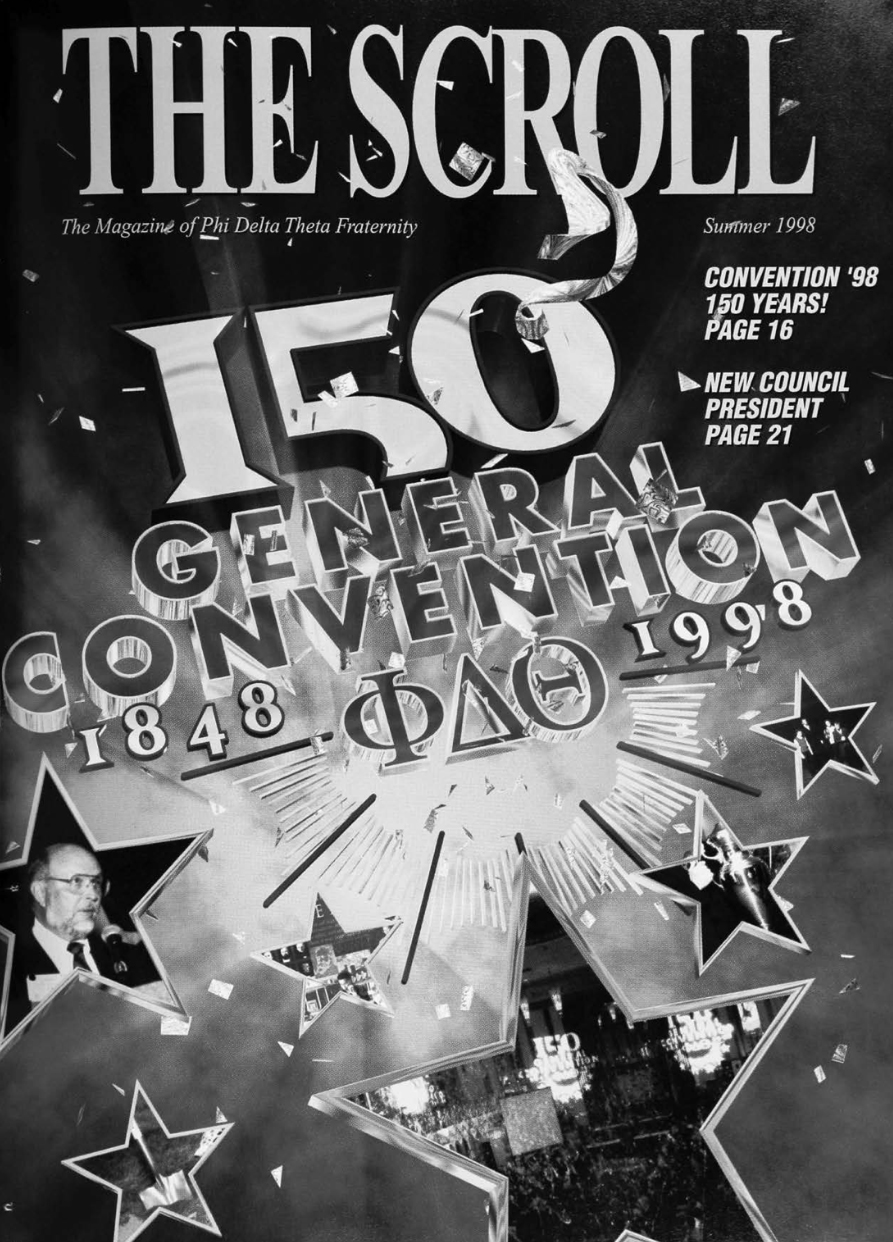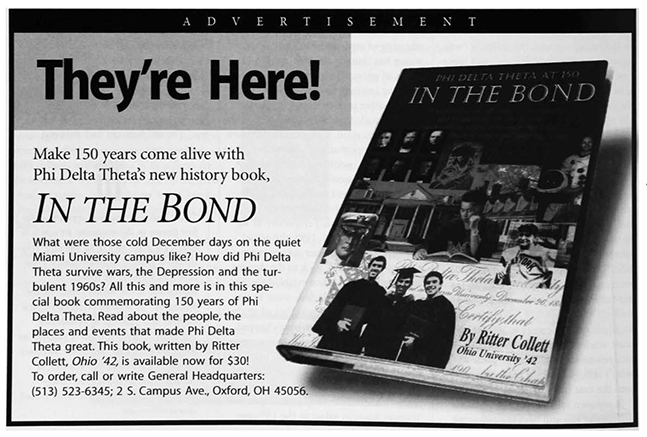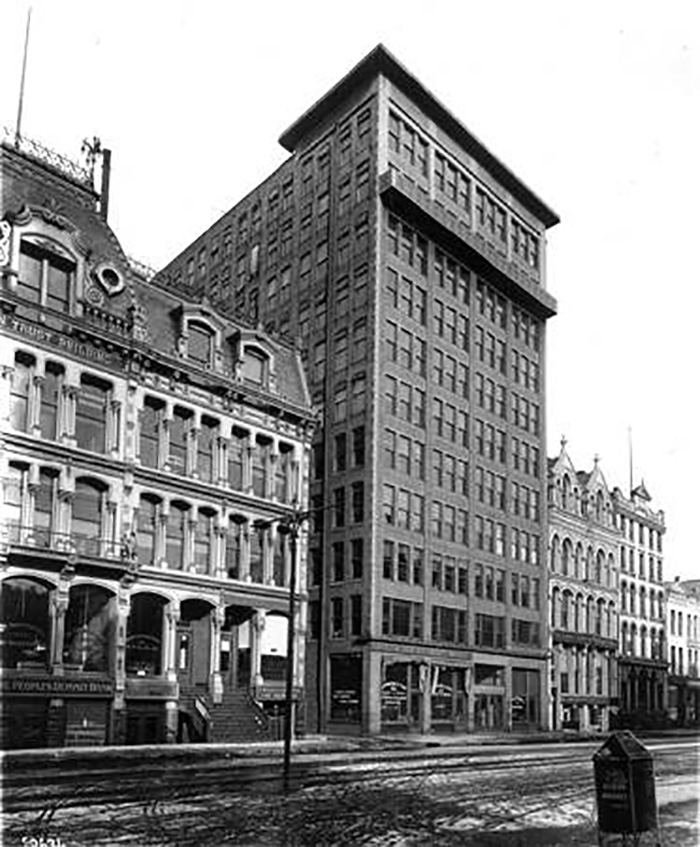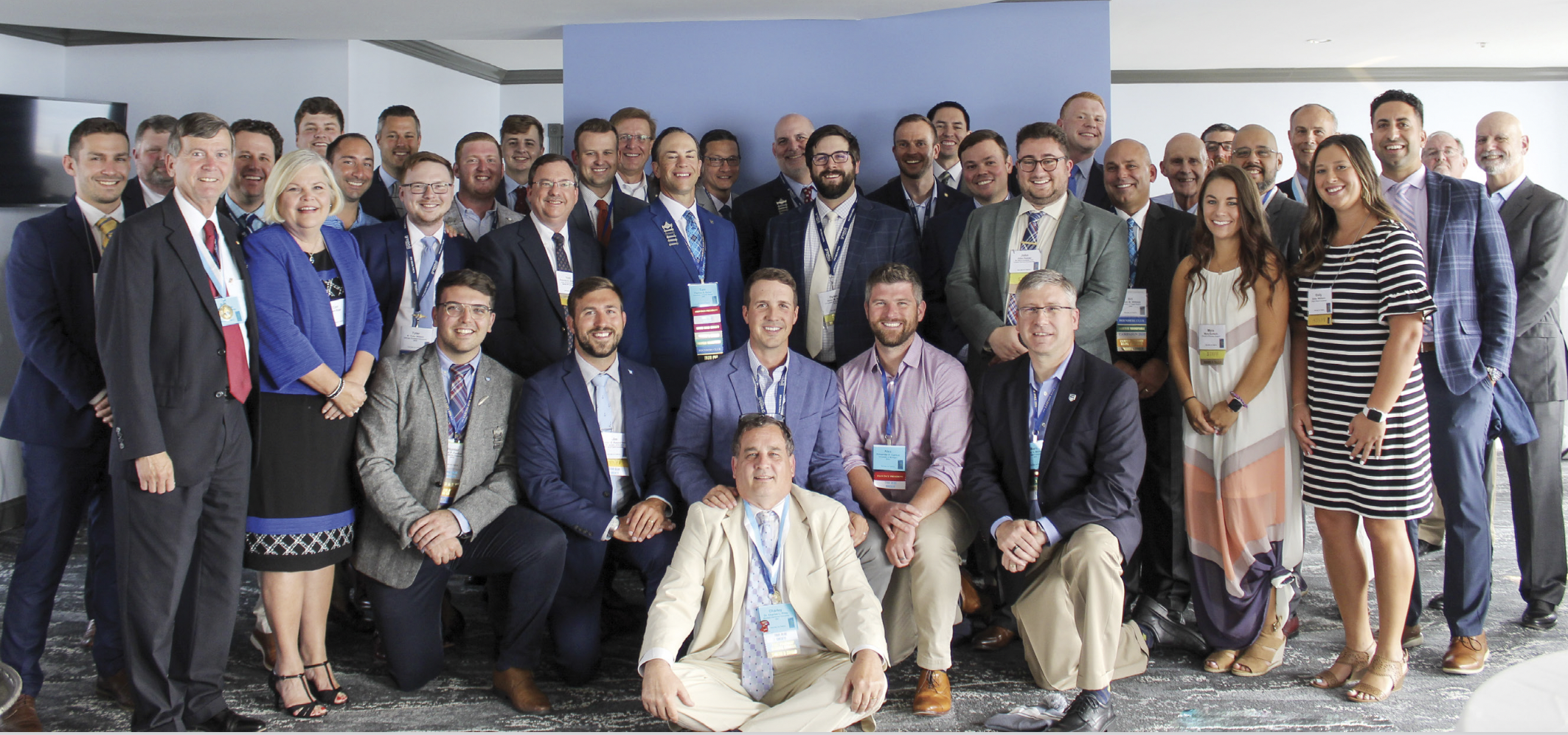From the Summer 1998 Edition of The Scroll
Music from the Cincinnati Brass Band heralded the opening celebration. They played awesome arrangements of familiar Fraternity compositions and American traditional overtures as Phis and guests entered the Hall of Mirrors at the Omni Netherland Plaza Hotel. It was obvious by this introduction that this Convention would be like no other. The hall darkened and spotlights with our Greek letters, coat of arms, and 150th logo shined brightly on the walls as the call-to-order was sounded by a dozen trumpeters blowing the Fraternity whistle.
Cincinnati Mayor Roxanne Quails proclaimed it “Phi Delta Theta Week” in the Queen City and Maestro Erich Kunzel, Dartmouth ’57, conductor of the championed Cincinnati Pops Orchestra greeted the Convention. Past Presidents of the General Council were introduced, culminated by the introduction of the current president, Dr. Robert B. Deloian, Arizona State ’66. As Dr. Deloian entered the hall he was saluted with “Hail to the Chief” and a five-minute standing ovation. He inspired the standing-room-only audience with his final State of the Fraternity address, received again by cheers and a thunderous ovation.
Silver and Golden Legionnaires were honored with full Fraternity pomp and ceremony. A video presentation of historic convention footage and greetings from three famous Phis awed those in attendance. Hall of Fame sportswriter Ritter Collett, Ohio ’42, then unveiled the new Fraternity history and recounted his two years of research.
Frank Wright, Florida ’26, a Florida Alpha founding father and seventy-three-year member of Phi Delta Theta, read the sesquicentennial greeting originally given by Robert Morrison at the Semicentennial Convention in 1898. Brother Wright was in attendance at the 1948 Centennial Convention and was entrusted with Morrison’s greeting originally read by Dr. John Edwin Brown, Ohio Wesleyan 1884.
Brother Wright, the 1998 Phi of the Year, then issued the following challenge: “I now charge someone here today who will be at the Bicentennial of 2048 to relay Father Morrison’s message to that convocation.”
Continuing in the Immortal Six theme was a visit from Robert C. Morrison, Westminster ’48, the grandson of Father Morrison. Brother Morrison wore his grandfather’s badge as he addressed the Convention. The badge is on display in the David D. Banta Memorial Library located at General Headquarters.
Convention delegates later traveled to Oxford to celebrate the birthplace of Phi Delta Theta at Miami University. The caravan of chartered buses first arrived at Miami’s Hall Auditorium, where they were met by former Miami president Philip Shriver. Dr. Shriver greeted his guests with anecdotal tales of campus life during the founding days of the Miami Triad. An Oxford acting troupe then recreated the 1848 founding of Phi Delta Theta within the chilly dorm room on the second floor of Old North Hall.
The Pilgrimage continued with a guided tour of the Miami campus. Sites highlighted were those of historical fraternity significance including the Phi Delt Gates (donated by the Fraternity as a part of our 125th anniversary), Elliott and Stoddard Halls (previously known as Old North and South Halls before being named in honor of two Phis), the bell tower donated by Beta Theta Pi, the slant walk, and of course, the site of the Snow Rebellion, Old Main, now called Harrison Hall in honor of Phi President Benjamin Harrison.
Following this historical trek through our Fraternity’s past, everyone gathered to celebrate our future under the warm June sun on the corner of Campus and High Streets, the location of our General Headquarters. Large blue and white tents encompassing the headquarters’ south lawn were filled to capacity. Hanging proudly from the south edifice of our headquarters was a tremendous Phi Delt flag and a large stage stood directly before this symbol of brotherhood. Fraternity songs filled the summer day until Executive Vice President Emeritus and Foundation President Emeritus Robert J. Miller, New Mexico ’50, climbed the stairs of the adorned stage to kick off a very special groundbreaking ceremony.
Brother Miller shared with the hundreds of Phis and guests off-the-cuff remarks about his two score-plus years as overseer of the venerable headquarters, now celebrating its golden anniversary. Brother Miller announced the Foundation’s ambitious plans to expand the current building in order to better serve our membership.
Brother Miller invited Foundation Trustee Dr. Paul Martin, Akron ’35, to say a few words. Dr. Martin and his late wife, Dorothy, have been tremendous supporters of both the Phi Delta Theta and Delta Gamma Foundations as well as their alma mater. After his thoughtful commentary on the historic occasion. Dr. Martin took a silver-plated shovel and officially turned the first dirt for the expansion. The Foundation Trustees, General Council, and then everyone in attendance gathered to seize a chance to throw some dirt during the groundbreaking.
Foundation President Rusty Richardson, Tampa ’80, unveiled the plans for the new headquarters expansion, which will allow the Foundation and Fraternity to operate under one roof for the first time in a decade. The completed building will also boast improved meeting and seminar space, as well as additional room for the display of items from the Phi archives.
Friday evening found Convention visitors taking advantage of their host city, Cincinnati. Many attended the Broadway production Beauty and the Beast, some saw Brother Erich Kunzel conduct the Cincinnati Pops at the Riverbend Music Pavilion, others dined in Cincinnati’s world-renowned restaurants and some attended special reunions and other impromptu gatherings.
The 1998 Convention legislative agenda was rather light in comparison to previous gatherings. The major responsibility was electing a General Council to lead the Fraternity during the next biennium, and this was met first thing Saturday morning. Chuck Poore, South Dakota ’60, was elected president of the Council. Council members Art Hoge, Westminster ’75, Scott Mietchen, Utah ’84, and Charley Pride, Western Kentucky ’87, were re-elected and George Lankow, Florida ’60, was elected to his first term.
Paul Smucker, Miami ’39, was the keynote speaker for the Foundation luncheon held on Saturday, during which he received the Nance-Millett Free Enterprise Award.
To commemorate the event, each table was adorned with miniature jars of Smucker’s jam which guests were invited to take home.
Also at the luncheon, the Foundation announced the 1998 scholarship winners and introduced the Graduate Fellowship Program that makes graduate school fellowships available to Phi grad students.
That evening the Grand Banquet was held in the Pavilion Ballroom. With the soothing sounds of local musicians, guests prepared for a hearty meal and a full program. Major chapter awards such as the Harvard, Kansas City, Founders, and Housser Trophies were presented to outstanding chapters. Dorothy Wright, wife of Richard Wright, Akron ’37, accepted the Legion of Honor on behalf of her husband. A local presentation had occurred in Akron shortly before Dr. Wright’s passing. Ritter Collett graciously accepted the Legion of Honor for his years of service on the Lou Gehrig Memorial Award Committee and the penning of the 150th-anniversary history book. Don Hilt, Indiana ’49, was presented with the Legion of Merit. The noble Frank Wright was presented with the Raymond L. Gardner Alumnus of the Year Award, and he challenged the audience:
Sunday morning the Convention remembered all those Phis who have entered the Chapter Grand during the past biennium. The Memorial Ceremony, accompanied by a bagpiper piping “Amazing Grace,” paid tribute to these friends and brothers.
The 72nd General Convention allowed us to reflect on the past, celebrate the present, and dream for the future.






